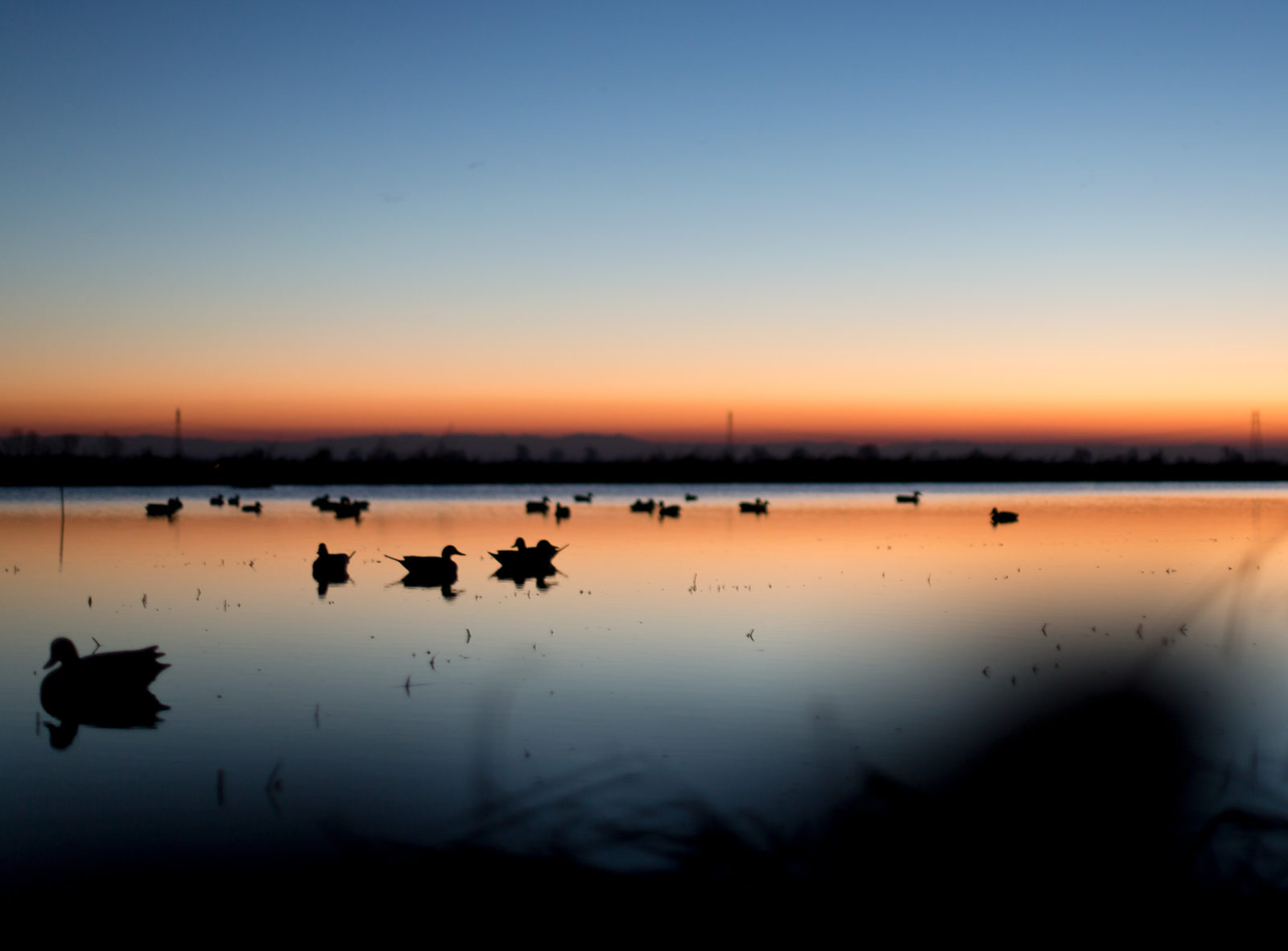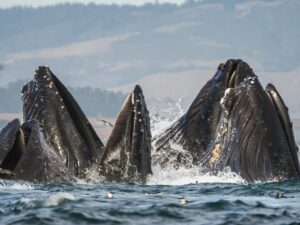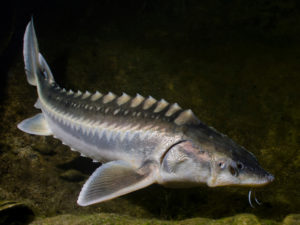here’s nothing like seeing dawn from a duck blind,” the noted Bay Area conservationist Huey Johnson told me. “There’s a real rhythm to it.” Two months later, I was sitting next to him on a wooden bench in a flooded Marysville rice field. As the predawn light emerged, I watched Bear, Johnson’s black Lab, snap his big puppy head in the direction of every sound. The rising sun seemed to cue the 18 tundra swans that flew overhead, followed by a cackling vee of white-fronted geese. Distant gunshots punctured the peace, and suddenly the cattail fluff in the tules looked like bird feathers.
Johnson talked in hushed tones with his Benelli 12-gauge at the ready. It’s disconcerting to interview someone with a loaded shotgun in his hands, even if that someone was the first western regional director of the Nature Conservancy and the founder of the Trust for Public Land, Grand Canyon Trust, and Resource Renewal Institute. When a pintail flew across our field of vision he took a shot and missed. It wasn’t his fault. He was busy telling me how he had saved the Seven Sacred Pools in Maui’s Haleakala National Park.
The field trip with Johnson was part of an extended series of lessons about the intimate and indelible connection between hunting and conservation. My first lesson came when I moved to Solano County and learned that the Suisun Marsh, the largest brackish wetland on the West Coast, was saved from development by private duck clubs. Before I moved to a rural-turned-suburban community that included hunters, I had lived in cities and didn’t know anything about hunters beyond the stereotypes I’d seen in The Deer Hunter and Deliverance. Part of the divide between hunters and nonhunters is urban vs. rural (hunting is part of the history and fabric of rural areas), but the division also stems from a belief on the part of some ecologists that killing an animal is inimical to the objective of conservation: the preservation of natural landscapes and the wildlife that inhabit them. But I have learned that many well-known conservationists honed their appreciation for the natural world with a gun in their hands, including John James Audubon, Theodore Roosevelt, and Aldo Leopold.
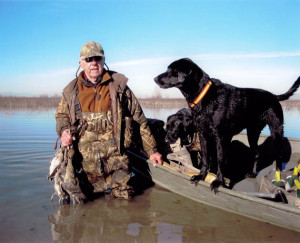
After that day in the field with Johnson, I decided to take a closer look at the connection between hunters and conservation. First of all, I was surprised to learn how much money hunters and fishers contribute to conservation through the purchase of licenses, stamps, and equipment. In 2014, the U.S. Fish and Wildlife Service distributed $25.3 million to California through the Wildlife and Sport Fish Restoration Program. The funds were funneled to agencies such as the California Department of Fish and Wildlife (CDFW) and the Coastal Conservancy for operations at places like Grizzly Island Wildlife Area and the Napa-Sonoma Marshes Wildlife Area and restoration projects like those at Sears Point, Giacomini Wetlands, and Bair Island.
“It’s not just the license fees, but their invaluable political support for preserving habitat, especially wetlands for migratory waterfowl,” says Richard Walker, professor emeritus of geography at UC Berkeley. “The same applies to fishermen and their associations, who support wild rivers, habitat restoration on rivers, and water flows for fish, as in the Delta. Hunters get more bad press among environmentalists than fishermen, but they are quite equivalent, though it’s easier to practice catch-and-release with fish than with deer or boar!”
For some hunters the connection goes deeper than pockets and further than politics. “People find it hard to understand that being a hunter is not only consistent with being a conservationist, but in some ways is part of being a conservationist,” says Steven McCormick, who recently stepped down as president and CEO of the Gordon and Betty Moore Foundation, and who before that worked for the Nature Conservancy for 30 years, including seven as president of the large national environmental group. “I am a conservationist and a hunter as one thing, not as two separate interests or passions.”
McCormick has walked the fields as conservationist and hunter for most of his life. He grew up in Tiburon, where as a boy he built a terrarium for the snakes, lizards, and frogs he collected; learned the names of trees; and joined the Sierra Club. He read Rachel Carson’s Silent Spring and Aldo Leopold’s Sand County Almanac. McCormick remembers his first hunt at age five when he and his father climbed the grassy hill behind their house and, with the 12-gauge Ithaca pump rifle that his father had given him, he shot at ducks flying from Richardson Bay to San Pablo Bay. He remembers that the recoil “hurt like hell” and that he missed.
“Hunting is a tradition, not a sport,” said instructor Tom Henderson during my CDFW hunter education class, a course that is required if you want to get a hunting license. “It’s not about shooting up the countryside; it’s about spending time with family.”

ot every hunter grew up in a family that hunted. Craig Anderson, the executive director of the environmental nonprofit organization LandPaths and Bay Nature’s 2014 Conservation Action award winner, was raised in a household without guns. In college he studied environmental science and restoration ecology and was a “Birkenstock-wearing, tofu-eating vegetarian.” His interest in hunting began years later when LandPaths acquired Riddell Preserve above Dry Creek Valley in Sonoma County, a property then overrun with wild pigs. Volunteer Dave Barry suggested a low-impact hunting program. Anderson agreed to try it and asked Barry to teach him to hunt.
Anderson was alone when he shot his first pig. “All of a sudden college boy was on a dirt road with a dead pig in a rainstorm,” says Anderson, who had field-dressed a turkey but not a pig. “I got under a madrone and with two bars on my Blackberry Googled ‘YouTube field dress pig.’ I pressed pause and play with my pinkie because it was the only finger that wasn’t bloody.”
Anderson says hunting gives him entree to social groups that he couldn’t reach as a conservationist; reduces the population of animals that don’t belong here; and provides local, organic, free-range meat for his family. “The final reason I hunt relates back to Leopold,” he says. “Hunting gives me an opportunity to be part of the ecosystem in a way that I’m not when I’m walking along with a clipboard and my agency colleagues and a landowner. It’s an enormous stress reducer to be out before dawn, huddled against a giant redwood tree calling in a turkey that might be dinner; to hear the owls hooting; and to watch the planets burning bright in the sky. We might have a better understanding of what it is to be humans on land, to be managers of both wild land and working landscapes, if we’re more part of that ecosystem.”
Another conservation hunter who wasn’t raised in a family of hunters is Heather DeQuincy. She grew up on the Peninsula in a milieu where she was expected to attend the debutante ball after she graduated high school. She donned a ball gown and elbow-high gloves and went, even though she had already started to move toward an “earth-based ethic.” In college she majored in environmental studies and sustainable agriculture, worked on organic farms, and became a vegetarian. Today, in addition to her job as a senior office assistant at the East Bay Regional Park District, she runs a landscape business that focuses on native and edible plants. Food, and where it comes from, plays an important role in her life.
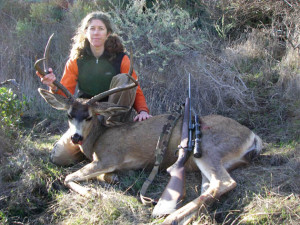
DeQuincy shot her first deer on Catalina Island in 2009. She later learned that the buck had the widest rack of any animal taken that year. “I felt overwhelmed with excitement and sadness, almost a devastation,” she said. “He was a lovely animal and it was a solemn experience.”
I asked DeQuincy if she had trouble pulling the trigger for the first time (I didn’t know if I could). She said she didn’t because she’d done her homework. “I wanted to feel purpose-driven enough that my emotions weren’t going to get in the way of my plan to hunt and shoot a deer and bring home meat for my family and friends to eat and sustain ourselves,” she said.
After giving it some thought, I concluded that I already pull the trigger every time I eat meat, even though I pay someone else to do it. So I asked Mark Heath to take me on a duck hunt. Heath is a habitat restoration specialist who leaves his San Francisco home at 4:30 a.m. during duck season to hunt pintail, mallard, and canvasback in North Bay marshes and is back in the city for work by 9 a.m. Heath leads hunting workshops for the Wildlife Society, California Waterfowl, and the Society for Conservation Biology and co-teaches the only hunter education class in the County of San Francisco. He has seen a spike in the popularity of his classes and a change in demographics, with more women, urban professionals, and ethnic diversity than before.
I met up with Heath on a January afternoon at Ringstrom Bay on the northern edge of the Napa-Sonoma Marshes Wildlife Area northwest of Vallejo. Ringstrom Bay is a freshwater seasonal wetland that is owned and managed by CDFW and was restored by Ducks Unlimited, a member-based national nonprofit that specializes in wetlands conservation from design to construction. Locally, Ducks Unlimited has played a major role in numerous projects, including Sears Point and Eden Landing.
Heath showed up in a hatchback with the necessary gear, and we waded through the knee-deep water until we reached a small island of bulrush at the far end of the bay, where we loaded our guns and watched and waited. A few wigeons flew by and landed out of range. At one point I took out my phone to take pictures and it was just then that a small flock of canvasback chose to fly overhead. The sun set early in the winter sky and as we packed up to leave a pintail flew above. My gun was still loaded.
“Shoot it,” encouraged Heath.
But habit prevailed and instead I admired the duck’s white belly.
We crunched through the pickleweed as the lights of San Francisco blinked on and a steady parade of ducks landed in the inky water, as if aware that it was against regulation to shoot after sunset.

he conservation hunters that I interviewed for this story not only agree with the rules and regulations imposed upon them, but exceed them. Anderson and DeQuincy have only hunted nonnative species; DeQuincy is adamant that if she were to shoot waterfowl, she would be well-educated about the health of their populations first; and others belong to clubs with self-imposed rules such as only shooting in the morning and taking less than the bag limit.
Most of these hypervigilant hunters are trained in biology or ecology and believe in the science and reasoning behind the limits. Not all hunters do. I talked to one hunter who is frustrated because he can’t feed his family of four by hunting due to the bag limits. Other hunters doubt the science behind the species counts and the resulting limits. The divisiveness cuts both ways, especially in communities with changing demographics such as Point Reyes, where hunters have bagged ducks at the Tomales Bay Ecological Reserve for four generations, and where a contingent of residents is now circulating petitions to stop them.
While it may seem logical to assume that scientists or naturalists were the first to advocate hunting regulations in America, it was actually the hunters — or, to put a finer point on it, the “sportsmen” — who did. By the end of the 19th century, sportsmen took care to separate themselves from the market hunters who supplied meat to California’s growing population after the Gold Rush. Hunters and nonhunters alike witnessed the disappearance of large game animals during the second half of the 19th century. In 1856 the Sacramento Daily Union boasted of the limitless opportunities to hunt deer, elk, and antelope and both species of bears, with the “grizzly everywhere to be met with.” By 1874 the same paper reported that the antelopes were gone, as were the elk that roamed San Francisco, Stockton, and Solano and Yolo Counties. “They have all been destroyed by the vandal pot-hunters, who regard neither season nor age, nor sex or condition of the game they slaughter,” the Daily Union lamented.
An old-time market hunter interviewed by Anthony Arnold for Suisun Marsh History said that he and his partner killed 100 to 200 ducks a day in 1879, and that their take was only limited by transportation. “Refrigerated railroad cars were critical to the expansion of market hunting,” says Stanford historian Richard White, “and played into why the passenger pigeon went extinct and why waterfowl populations plummeted.” In 1910, 500,000 ducks were sold in San Francisco, and four years later that number had dropped to 28,425 birds. “Past practices of mass slaughter, here and elsewhere, were so offensive than a foul odor still hangs over all hunting,” says Walker. “Recreational hunting gets confused with market hunting, so it’s good to make that distinction.”
Newspapers and national outdoor sports magazines called for restrictions, and George Bird Grinnell, the editor of Forest and Stream, became the voice of conservation. Grinnell also founded the Audubon Society in response to the slaughter of millions of herons, egrets, and other birds for the use of their plumage on hats. Grinnell helped to establish the “code of the sportsman,” which advocated for the noncommercial use of all game killed, writes John F. Reiger in American Sportsman and the Origins of Conservation. Sportsmen taxed themselves, pushed for state regulations, and formed game reserves, such as the duck clubs in the Suisun Marsh. The code is alive for some hunters, while for others it is enforced only through regulation.
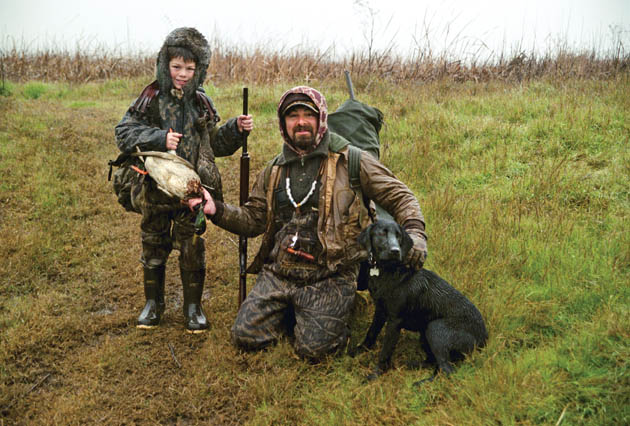
fter my unsuccessful duck hunt, Heath suggested I try turkeys. So a few months later, I went for a hunt with Bradford Smith, professor emeritus of veterinary medicine at UC Davis and author of Large Animal Internal Medicine. We pitched Smith’s pop-up camouflage tent in the middle of a walnut orchard in Winters, where in the dark we could hear turkeys gobbling in the taller trees to the left and right of the orchard.
The orchard was next to John Anderson’s seed farm in Yolo County. Anderson is a California native grassland specialist and founder of Hedgerow Farms, a seed producer of California native grasses, forbs, sedges, and rushes. Anderson bought his 500-acre farm when he was a primate vet at UC Davis and began to “reconstruct” (his term) the land in the 1970s after being inspired by the prairie grassland restorations he saw at the Aldo Leopold Center in Wisconsin. Though much of Anderson’s land now functions as a seed farm, its borders and riparian edges are alive with wild rose, redbud, blue elderberry, deer grass, and coast live oak, and his property teems with beneficial insects, birds, and wildlife. Anderson has served on the boards of Audubon California, the California Native Grasslands Association, and the Yolo County Resource Conservation District. He also hunts rock dove, quail, deer, wild pigs, and turkeys on his property. I had asked Anderson to take me out for a hunt, but he was busy and asked Smith, a hunting buddy, to guide me.
Smith and I sat quietly on stools inside the tent with nets over our faces and the mesh windows open. A borrowed over-under shotgun with one shell sat on my lap. Smith explained in a whisper that we would only shoot the males, which were recognizable by their red heads and “beards.” Once the sun came up, the turkeys came down from their roosts. Smith called them with a reed, but they were not lured. We waited, whispered, and didn’t make any fast movements.
After two hours we gave up on the orchard and drove to a hedgerow where we watched a flock of turkeys on the other side of the field. Smith tried his reed, but the turkeys continued their leisurely gait.
“I think the turkeys are safe for today,” I whispered.
“It’s not over yet,” said Smith. We followed them in the truck, stalked them on foot through more hedgerows, and saw that they were headed for Anderson’s guesthouse. We followed and ran into John Anderson, who gave us permission to shoot close to his house.
With a woodpile for cover, Smith, who is not a young man but is fit, crawled on his belly to stake a female decoy in the ground six feet beyond the woodpile. He crawled back to where I was crouched, said something in a whisper that I couldn’t hear through my earplugs, and disappeared behind the guesthouse.
All was quiet. I was more aware of my surroundings as a hunter than I would have been as a spectator with binoculars.
Gobble. A jake turkey, a young male, came out from behind a pine and headed for the decoy. Smith was nowhere to be seen. The bird came closer to the decoy and I clicked my safety off. Wait; was that a male for sure? The beard didn’t look like the one on the decoy. Safety on. Should I shoot the bird without my guide here? Yes, he would want me to shoot this bird. Safety off. I knelt for better stability, but first, safety on.
The bird reached the decoy. I was on my knees and had it in my sights.
“Shoot it,” I could hear Heath say. Safety off.
My gun sight was on the turkey’s head. He looked at me but didn’t move right away. Smith said that jacks were young and tender and delicious when roasted, and I liked the idea of bringing one home for dinner.
And yet, I didn’t squeeze the trigger. The turkey sauntered off, as if he knew I wasn’t going to kill him.
I lowered my gun, clicked on the safety, and took out my earplugs.
“Did you see the turkey?” Smith said as he came around the corner of the guesthouse. “I shooed it towards you.”
“I had the shot but didn’t take it,” I said, with a mixture of remorse and relief.
On the way home I considered why I hadn’t pulled the trigger. I knew it wasn’t an ethical or moral decision; I had already worked that out. For me it was an emotional decision. I just couldn’t pull the trigger, not on that day. Though I have to admit, I’m more than a little tempted to try again.
“Everyone has done something similar,” said Smith when I told him I had mixed feelings about the one that got away. “You had all the excitement, but didn’t have to clean the bird.”
Aleta George writes about nature and culture in California.

